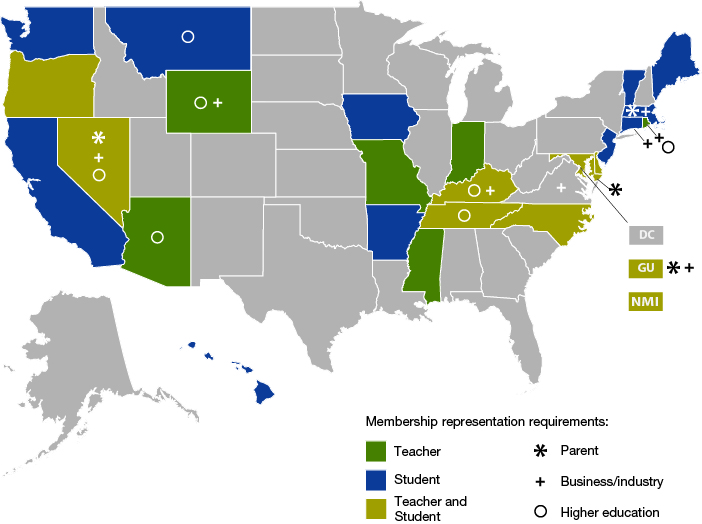Data Snapshot: Reserved Seats on State Boards

Twenty-five states require a teacher and/or student member on their state board of education, according to a scan of state statutes and codes related to state board makeup (see map). Eighteen states require a student member, voting or nonvoting, on their state board. Four additional states require student members on their boards in policy or bylaws, not law.

Fifteen states require a current teacher to be a member. However, 18 states prohibit current teachers from serving on the board or limit the number of teachers that can. While Delaware, Kentucky, Maryland, Mississippi, Tennessee, and the Northern Marianas Islands do require current teachers to sit on the board, they limit teacher membership to only one voting or nonvoting seat. North Carolina holds an advisory seat for the state teacher of the year but also restricts three or more public school employees from serving on the board at the same time.
Maryland, Massachusetts, Nevada, and Guam reserve a seat for a parent representative. In Massachusetts’ case, a nominee from the Massachusetts PTA fills this position. Alaska and Hawaii hold advisory seats for military representatives. Seven states require a school administrator or principal, eight require representation from business or industry, and eight have slots for higher education representatives. Statutes in 11 states require the governor or other authority to appoint members of a political party that differs from their own.
Also In this Issue
How States Are Investing in Community Schools
By Anna MaierPlenty more for state boards to do to foster faithful implementation of a strategy that is boosting outcomes in many communities.
California Ramps Up Support for Community Schools
By Joseph Hedger and Celina PierrottetThe state bets big on a long-term strategy to marshal resources to help the neediest students and improve their schools.
How Tennessee Is Better Addressing Workforce Needs
By Robert S. EbyActive, ongoing collaboration of businesses, K-12, higher education, and other partners is key.
Eight Ways States Can Build Better Family Engagement Policies
By Reyna P. Hernandez, Jeffrey W. Snyder and Margaret CaspeState boards can model how to engage families in decision making and guide schools and districts in best practices.
Expanding Afterschool and Summer Learning to Boost Student Success
By Jodi GrantToo many young people miss out, while community programs struggle to stay afloat.
Leveraging Community-Based Organizations for High-Dosage Tutoring
By Jennifer Bronson and Jennifer KrajewskiCommunity-based organizations have the knowledge and networks to expand the proven strategy for learning recovery.








 i
i
 i
i
 i
i